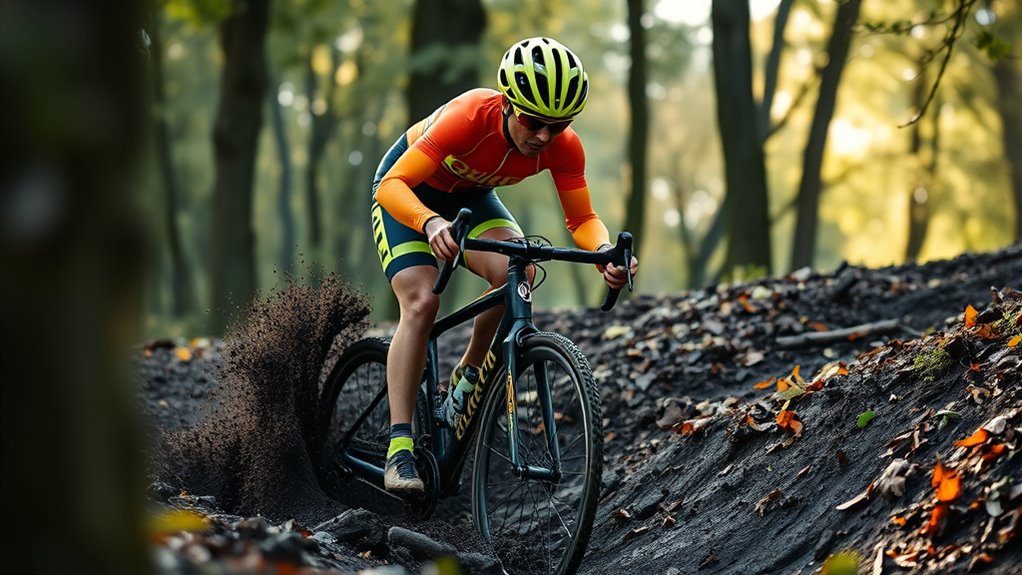To improve your cyclocross skills and fitness, focus on building strong bike handling, balance, and obstacle navigation through regular drills like tight turns and mount/dismount practice. Incorporate explosive plyometric exercises and interval rides to boost power and endurance. Train on muddy and technical terrain to develop confidence in various conditions. With consistent effort in these areas, you’ll become more agile and resilient. Keep exploring these tips to unleash even greater performance on race day.
Key Takeaways
- Focus on fundamental bike handling, including proper positioning, smooth braking, and technical drills like tight turns and obstacle crossing.
- Incorporate obstacle navigation techniques such as controlled mounting, dismounting, and wheelie clearance for confidence.
- Develop explosive power and endurance through plyometrics, resistance training, and sustained moderate rides.
- Train on variable terrain, practicing mud, loose sections, and technical features to improve grip and handling.
- Use interval and sprint drills on race-specific courses, plus mental visualization to boost race readiness and confidence.
Building Fundamental Bike Handling Skills
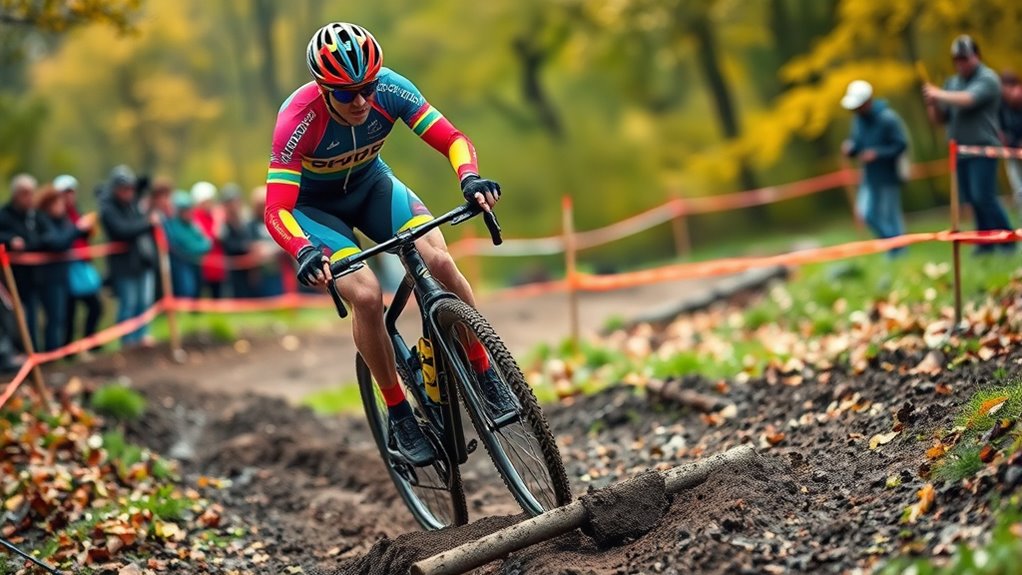
Developing strong bike handling skills is essential for success in cyclocross. Your bike fit directly impacts your control and comfort, so make sure your bike is properly adjusted to your body. A well-fitted bike allows for better maneuverability, especially on technical sections.
Equally important are nutrition strategies that keep your energy levels steady during races, preventing fatigue that can hinder your handling. Focus on eating carbohydrate-rich foods before and during your ride to maintain focus and responsiveness.
Practice braking smoothly, cornering confidently, and balancing on uneven terrain. These foundational skills build confidence and improve your ability to navigate obstacles efficiently.
Incorporating proper bike fit and nutrition into your training creates a solid base for mastering tougher cyclocross sections.
Mastering Mounts and Dismounts
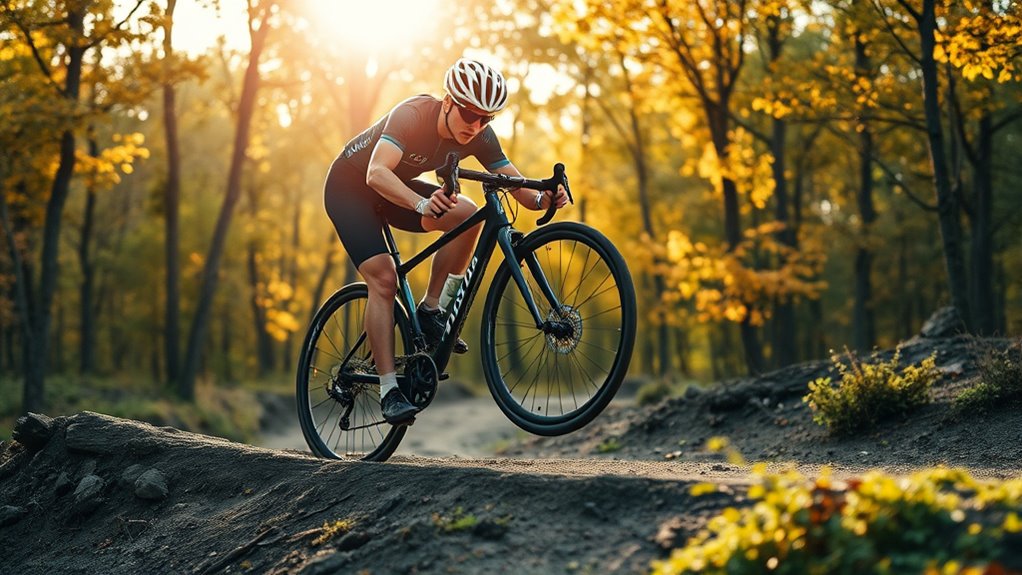
Mastering mounts and dismounts is a fundamental skill that allows you to shift smoothly between riding and obstacle navigation. To improve your mounting techniques, practice a quick, controlled step onto your bike, keeping your weight balanced and your eyes forward. Focus on a fluid motion, planting your pedal and swinging your leg over, avoiding hesitation. Using a high-quality projector technology can also be helpful when reviewing your technique videos to analyze and improve your form. Incorporating appliance maintenance plans into your routine can ensure your gear remains in top condition, similar to how regular bike checks are essential for optimal performance. Paying attention to performance tuning can significantly enhance your riding efficiency and responsiveness. When it’s time to dismount, develop effective dismounting strategies by timing your move early, releasing pressure from the pedals, and stepping down confidently with your dominant foot first. Keep your body relaxed and your movements deliberate to maintain balance and momentum. Regularly practicing these techniques builds muscle memory, making your mounts and dismounts seamless, efficient, and safe—crucial skills for tackling the demands of cyclocross courses. Additionally, incorporating digital literacy strategies can help you stay informed about new training techniques and safety tips. Proper equipment selection also plays a vital role in ensuring smooth transitions and safe dismounts, so choose gear suited to your skill level and course conditions.
Navigating Obstacles Effectively
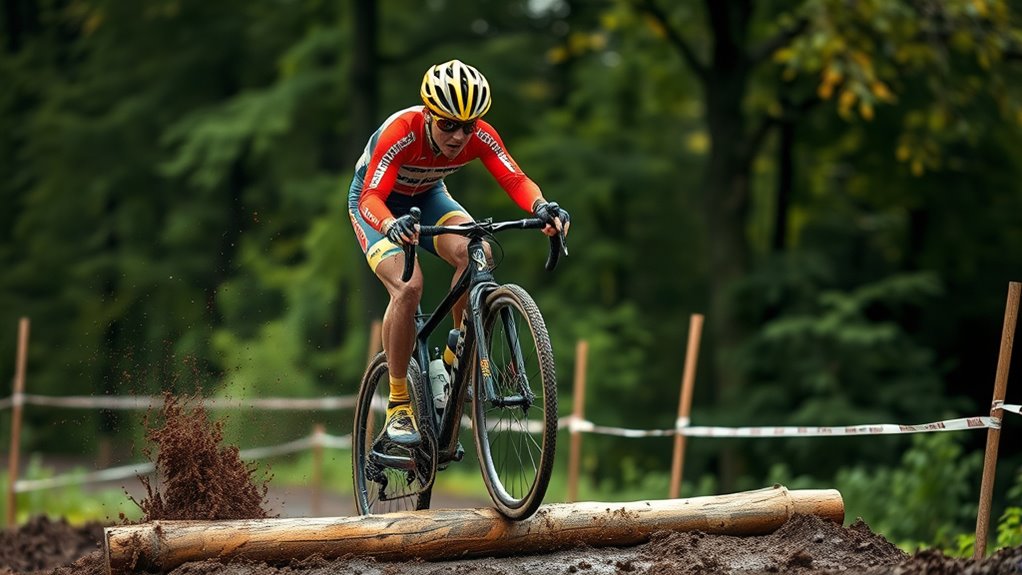
To navigate obstacles effectively, you need to approach each one with confidence and precision. Focus on your wheelie techniques to clear barriers smoothly, practicing controlled lifts and landings. Tire pressure strategies are also *vital*; lowering pressure improves grip and shock absorption, making obstacle crossings easier. Additionally, understanding best anime movies can provide inspiration for maintaining focus and composure during challenging sections of the course. For example, incorporating unique and wicked planters into your training environment can boost your motivation by creating a more engaging and inspiring setting. Recognizing the importance of trust in relationships can help you stay composed and confident under pressure when facing difficult obstacles. Developing a mindset of community engagement encourages sharing techniques and learning from others, which can accelerate your skills improvement. Here are key tips:
- Practice wheelie techniques to master lifting your front wheel over barriers without losing balance.
- Adjust your tire pressure based on terrain—softer for rough sections, firmer for smoother surfaces.
- Scan the obstacle early to plan your approach and select the best line.
- Maintain momentum by staying relaxed and fluid, avoiding abrupt movements that can unbalance you.
Developing Power and Explosive Strength
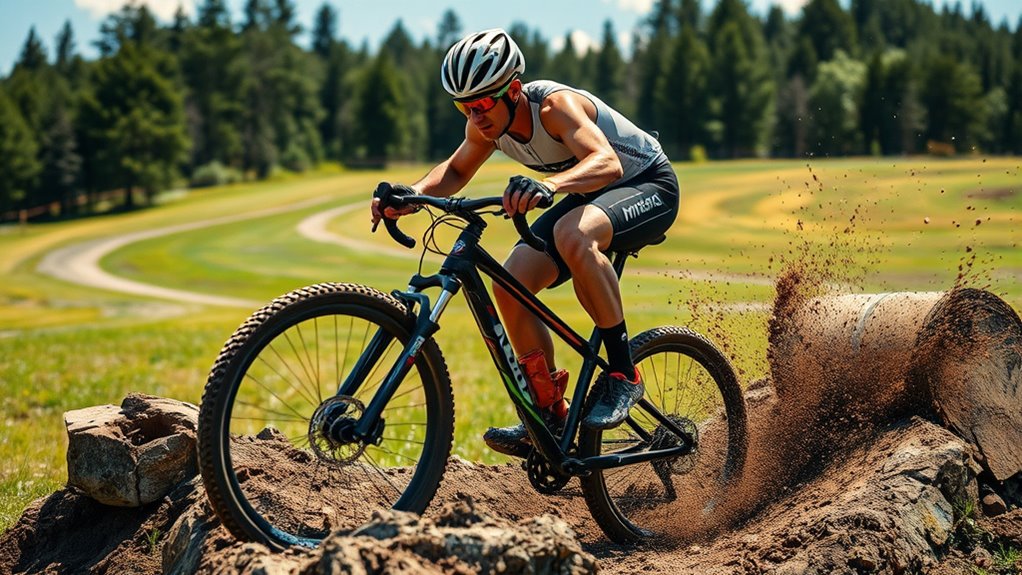
Building explosive strength is essential for powering through tough sections and launching over obstacles. Incorporate plyometric exercises like box jumps and burpees into your routine to boost your quick-twitch muscle fibers. Resistance training with kettlebells or free weights also builds overall power, making your pedal strokes more forceful. Focus on explosive movements rather than slow, controlled reps to maximize gains. Incorporate balancing poses to improve stability and coordination during explosive efforts. Engaging in dynamic muscle recruitment exercises enhances your ability to generate quick, powerful movements. Additionally, paying attention to proper headphone connections can ensure uninterrupted audio during training sessions, especially when using wireless or Bluetooth devices. Incorporating proper nutrition supports muscle recovery and energy levels, further amplifying your explosive power. Here’s a quick guide:
| Exercise Type | Examples |
|---|---|
| Plyometric exercises | Jump squats, tuck jumps |
| Resistance training | Deadlifts, kettlebell swings |
| Focus | Fast, powerful movements |
| Benefits | Improves acceleration |
| Tips | Maintain proper form |
Consistent practice will help you develop the explosive strength needed for cyclocross success.
Enhancing Endurance for Long Races
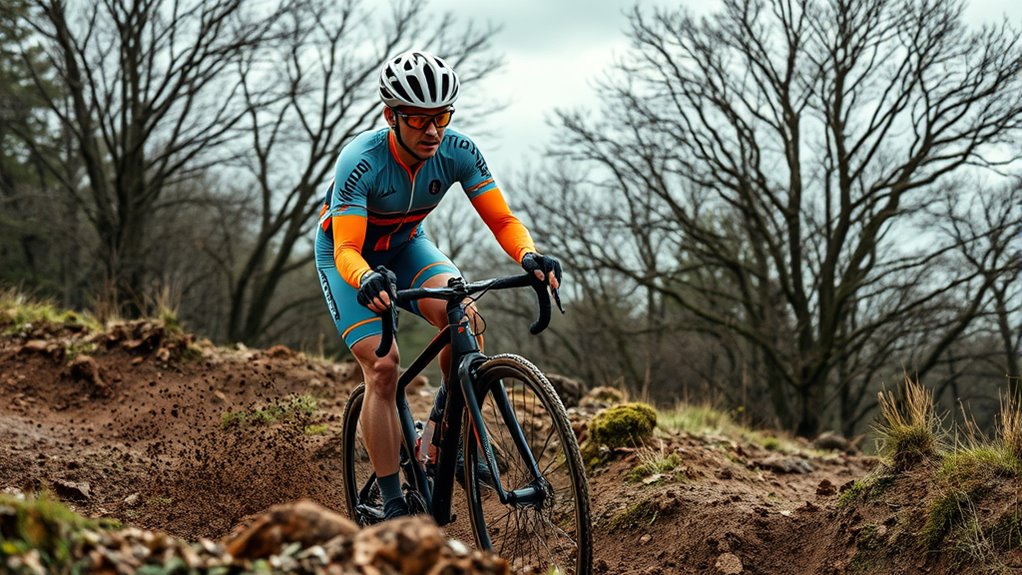
Since endurance is essential for lasting through long cyclocross races, you need to focus on training methods that boost your stamina and aerobic capacity. To do this effectively, consider these strategies:
- Incorporate sustained rides at moderate intensity to build aerobic endurance. These rides help increase your cardiovascular capacity and overall stamina. Additionally, integrating proper gold IRA management practices can ensure your investment remains secure and aligned with your retirement goals.
- Prioritize nutrition strategies that fuel your body and prevent fatigue during extended efforts.
- Practice mental resilience by setting small goals during training, staying focused, and managing race stress.
- Gradually increase your training volume, allowing your body to adapt without overtraining.
- Incorporate effective filtration and pump protection that support your recovery and maintain your motivation throughout training cycles. Understanding how to optimize general ledger coding can also help you manage your training finances more effectively.
Improving Cornering and Technical Skills
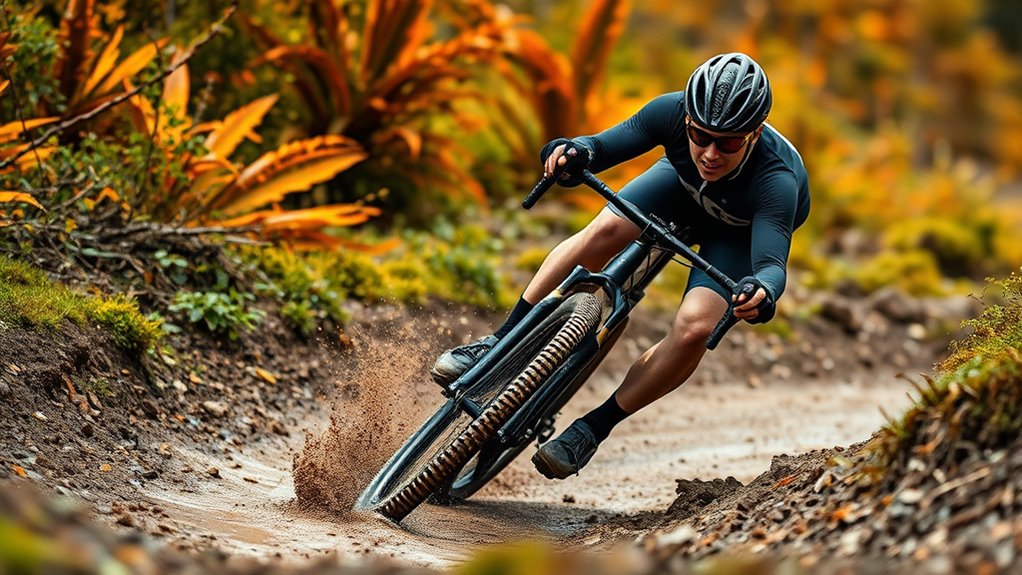
To sharpen your cornering and technical skills, focus on perfecting your bike positioning to stay balanced and quick through turns.
Practice maneuvering obstacles like barriers and steep descents to build confidence and control.
Mastering these skills will make your rides smoother and more efficient on challenging courses.
Mastering Bike Positioning
Mastering bike positioning is essential for improving your cornering and technical skills in cyclocross. Your riding posture and bike fit directly influence your control and agility. To optimize your bike position:
- Make sure your bike fit is tailored to your body, allowing for comfortable, efficient movement.
- Keep your elbows out and relaxed to enhance stability during sharp turns.
- Shift your weight slightly forward when approaching corners to maintain traction.
- Maintain a low, centered riding posture to improve balance and responsiveness.
- Incorporate proper equipment setup to further refine your positioning and overall control. Additionally, ensuring your bike is equipped with appropriate tires can significantly improve grip and cornering ability on varied terrain. Paying attention to bike geometry can also help you achieve a more effective riding stance tailored to cyclocross courses.
Navigating Technical Obstacles
Mastering technical obstacles effectively requires sharp skills and quick reflexes. To improve your cornering and technical handling, focus on bike maintenance—ensure your tires are properly inflated and your brakes are responsive. A well-maintained bike responds more predictably on tricky sections. Incorporate automation technologies that can help simulate challenging scenarios and track your progress during practice. In addition, incorporate nutrition strategies that keep your energy levels steady, preventing fatigue that hampers focus. Practicing technical drills regularly, such as tight turns and obstacle crossings, helps develop confidence. When approaching a challenging section, stay relaxed and maintain a low center of gravity for better control. Use your body weight and look ahead to plan your line. Embracing focusing techniques can also enhance your concentration and reaction times during demanding segments. Understanding the resources and tools available for training can further optimize your practice routines and skill development.
Training for Mud and Variable Terrain
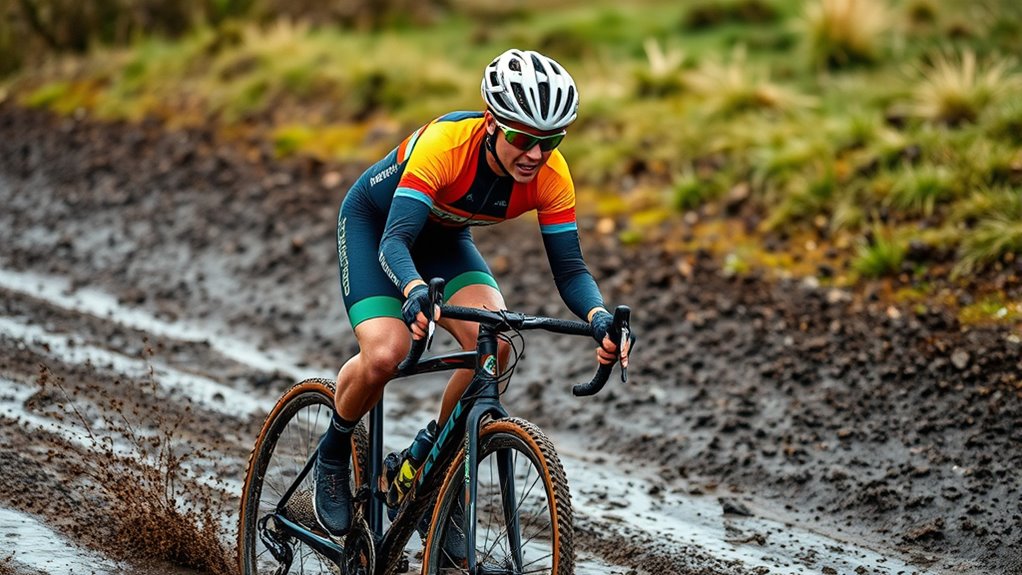
Training for mud and variable terrain requires you to adapt your technique and build specific skills that differ from riding on firm surfaces.
First, adjust your tire pressure lower to improve grip and mud clearance, preventing your wheels from clogging.
Second, practice maintaining a steady, controlled cadence to navigate slick, uneven ground without losing traction.
Third, focus on weight distribution; leaning back slightly helps keep the front wheel light and improves mud clearance.
Fourth, develop bike handling skills by riding through mud patches and loose sections regularly, sharpening your ability to stay balanced and confident.
Incorporating Interval and Sprint Workouts
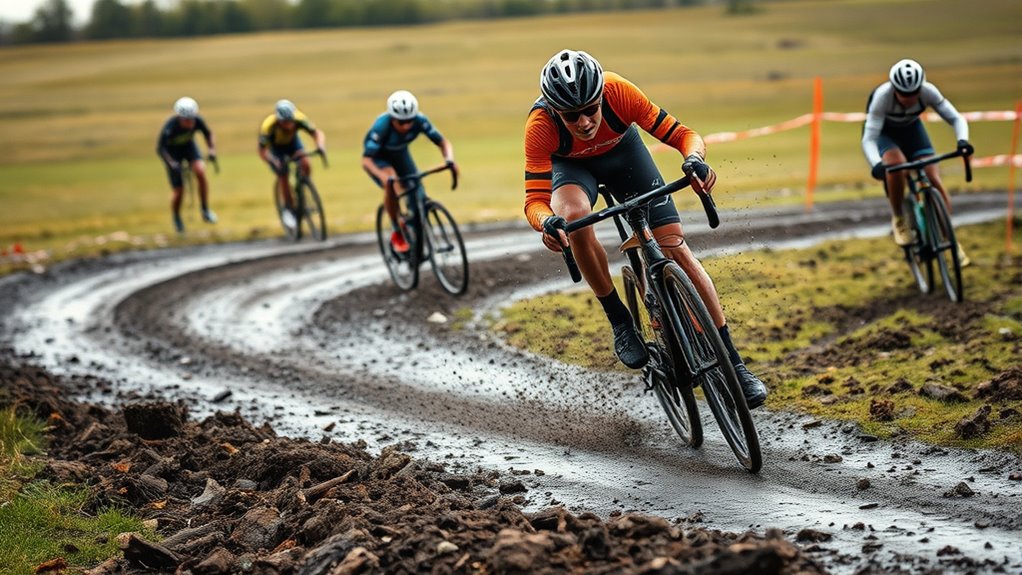
Building on your efforts to handle mud and tricky terrain, adding interval and sprint workouts to your training plan can considerably boost your power and speed.
Incorporate interval pacing into your sessions by alternating high-intensity efforts with recovery periods, which improves your stamina and bike control during races.
Sprint drills are equally essential; they mimic the explosive bursts needed to power through short sections or accelerate away from competitors.
Focus on short, intense sprints of 20 to 30 seconds, followed by equal recovery time.
These workouts increase your anaerobic capacity and help you develop the ability to surge when necessary.
Consistently integrating interval pacing and sprint drills will make you more agile, responsive, and ready to tackle the demanding nature of cyclocross courses.
Preparing for Race Day Conditions
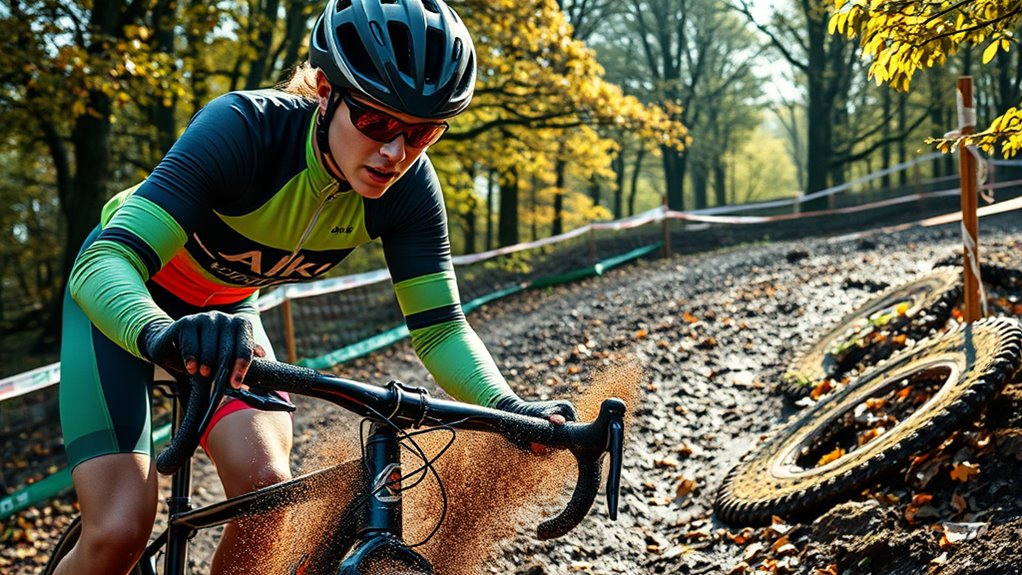
Preparing for race day conditions requires careful planning to guarantee you’re ready for whatever the course throws at you. First, check the weather forecast to determine if rain gear is necessary—staying dry can improve your traction and comfort.
Second, adjust your nutrition strategies; pack energy gels and hydration options suited for wet or muddy conditions.
Third, consider your tire choice: wider, knobby tires provide better grip in challenging terrain.
Fourth, mentally prepare for variable conditions—visualize racing in rain or mud to build confidence.
Frequently Asked Questions
How Should I Tailor My Training for Different Cyclocross Courses?
To tailor your training for different cyclocross courses, focus on understanding the course terrain and obstacles you’ll face. Practice riding on varied surfaces like mud, sand, or grass, and work on obstacle handling skills such as mounting, dismounting, and carrying your bike.
Adjust your intensity and technique based on the course’s unique features, ensuring you’re prepared to tackle steep hills, tight corners, and technical sections confidently.
What Nutrition Strategies Optimize Performance During Intense Cyclocross Races?
To optimize performance during intense cyclocross races, focus on hydration strategies and high energy snacks.
Drink fluids regularly to stay hydrated, especially during breaks, and consider electrolyte drinks to replace lost salts.
Consume high energy snacks like energy bars, gels, or bananas before and during the race to maintain your energy levels.
This combo keeps you fueled and hydrated, helping you stay focused and perform at your best throughout the race.
How Can I Prevent Injuries During Technical Cyclocross Training?
To prevent injuries during technical cyclocross training, always wear protective gear like helmets, gloves, and pads.
Incorporate injury prevention exercises such as core strengthening and balance drills into your routine to build stability and resilience.
Focus on proper technique and gradually increase intensity to avoid overloading your body.
Listening to your body and taking rest days also help prevent overuse injuries, keeping you safe and ready for the race.
What Is the Best Recovery Routine After a Tough Cyclocross Session?
After a tough cyclocross session, you should prioritize recovery to prevent injuries and improve performance. Start with post-ride stretching to loosen tight muscles, especially in your legs and hips.
Follow up with foam rolling to release muscle tension and increase blood flow. Hydrate well and refuel with a balanced meal.
Rest is essential, so give your body time to recover before your next ride.
How Do Weather Conditions Affect Cyclocross Training and Race Strategies?
Weather conditions greatly influence your cyclocross training and race strategies. Muddy conditions demand better bike handling skills and patience. Wind resistance can slow you down and drain energy.
You should adjust your pace and tackle technical sections differently in these conditions. Wearing appropriate gear and choosing ideal lines help maintain momentum.
Being adaptable and prepared for changing weather ensures you stay competitive and safe during races and training sessions.
Conclusion
By mastering fundamental skills and building your fitness, you prepare for the unpredictable nature of cyclocross. While technical agility keeps you moving through obstacles, raw endurance powers you through longer laps. Balancing explosive power with sustained effort guarantees you’re ready for mud, sharp turns, and tough conditions. In the end, your progress isn’t just about speed but resilience, proving that strength and skill—like challenge and triumph—go hand in hand on race day.
